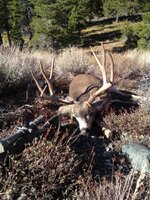T the OP:
I read your post, and just wanted to say thank you for posting. I definitely learned a thing or three! I have been hunting D5 since I was 12. I have taken some monsters out of places no one else hunts (never seen another hunter). It’s just not an easy place to be, but it has some big bucks and bears. I am close to 60 now, and still backpack hunt. Took a nice elk in Montana last year, on my last day!
Being quiet while hunting is key. Sleeping on the ground in the area you plan on hunting is also good advise. I will add the following for rifle hunting…
1. The type of ground you’re walking on is irrelevant, how you step on it, and the speed you move is relevant. Place the outside edge of your boot heal on the ground first, then slowly roll the entire outside edge down, and then place all of the boot down (listen and feel as your do this); as you begin to transfer weight, listen and feel again, if at anytime it doesn’t feel right, or sound right, place your boot in another spot and start over. With each step, pause and slowly look around, then take another step. My dad would tell me, you need to move like an Indian (feather not dot). Practice sneaking up on deer in the off season. Practice sneaking up on birds, and other wild animals. Learn what makes them run away, and practice getting close to them with a camera and take a picture. This will help you when it comes time to harvest.
2. Get to the area ya want to hunt an hour before first light. Move slowly. Most the deer I have harvested I killed while I was moving and came upon them. If they move when ya first see them, be patient, they tend to stop once and look back before they disappear, but not always. If they don’t move when ya fist see them, very slowly move your rifle into position to shoot. It once took me two minutes to bring my rifle into position as the buck was only 45 yards away and looking right at me as I moved up ontop a rocky area and saw him down below as I moved and my view of the area he was at become clear. Had I moved into that area quickly, I would have never seen him. Be able to take standing unsupported shots at 100 yards. This requires training and upper body strength. Don’t take shots like this if you’re not comfortable doing so.
3. Learn to listen. You can’t hear as well when you’re moving, so move slowly, stop and listen. Develop your third sense, its real, and it can guide and alert you. When looking, don’t just look at what you see, "trees, rocks, stumps, etc", but look hard into the areas that don’t have anything in particular to see, this is also a skill that requires practice (Kims Game).
4. Stop in spots where you’re concealed, sit down and wait, 20 minutes to half hour, then move as per above to another area. I have had good success doing this. I don’t usually stay in one place longer than 15-20 minutes.
5. Hunt while its raining! But you have to be moving. I have never not harvested a buck while moving in the rain, even hiking out on the last day in a heavy down poor! Bucks will get up from their beds when its raining to eat and stay warm, they usually don’t stay bedded down all day while it’s raining (this is opposite of what my dad learned me). Your scent and sound are harder for deer to pick up when its raining, so get out of the tent, put the rain gear on and get after it!
6. Use the wind to hide your scent, don’t trust the talcum powder when the wind is less than 10 mph, it only tells you what your scent is doing in the spot you are at. I use small pieces of burlap, very small, so small that it floats on the air, and can barely be seen. Watch were it goes, it will open your eyes to how your sent can move and change directions different from where it started. This works best when the wind is 1-3 mph, or you don’t feel much wind at all. Practice this before hunting season.
7. Finally, enjoy being alone and away from people in the wilderness. Enjoy the beauty all around you. Learn to be content with just being there, and let the harvesting of meat be secondary. If you get too wrapped up in harvesting, you’ll likely not harvest.
This beautiful D5 buck was harvested above 8000 feet while moving like an Indian. I fist noticed what I initially believed to be a doe, and when I brought my scope up slowly to get a closer look, I saw something flicker in the far left area of my optic, when I moved the rifle left to see what flickered, I saw this monster standing near a tree (learn to look at what ya don’t see). He was 115 yards away and I didn’t waste any time getting comfortable to shoot. Standing unsupported, I placed the cross hairs on the right spot, focused on the cross hair (not the animal), and slowly pressed the trigger at my natural respiratory pause with good follow-through.
He dropped where he stood. The other deer I thought was a doe turned out to be a spike, and he stayed right next to this one until I was within 25 yards, then he turned and walked away slower.
Enjoy,
Gar
View attachment 576069

